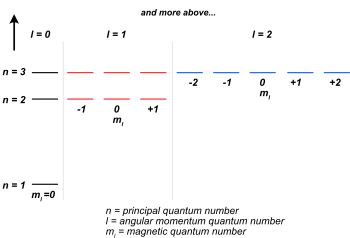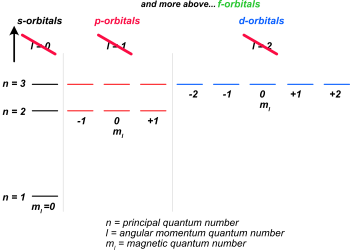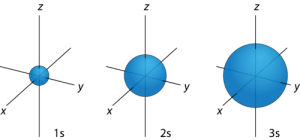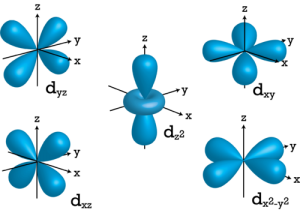Difference between revisions of "Ch7 Lec 4"
(Created page with "(4/27/20, bes) Greetings...it looks like the weather is starting to turn for the better. I planted some basil and cucumbers outside as a test to see if the night temps in the...") |
|||
| (10 intermediate revisions by the same user not shown) | |||
| Line 11: | Line 11: | ||
<div align="center"> | <div align="center"> | ||
{| | {| | ||
| − | |[[File:energy_level_00.png| | + | |[[File:energy_level_00.png|350px]]||--> ||[[File:energy_level_00b.png|350px]] |
|} | |} | ||
</div> | </div> | ||
| + | |||
| + | ===Orbitals=== | ||
| + | :''l=0'' --> s-orbital, 1 s-orbital per ''n''-value, | ||
| + | :''l=1'' --> p-orbital, 3 p-orbitals per ''n''-value, | ||
| + | :''l=2'' --> s-orbital, 5 d-orbitals per ''n''-value, | ||
| + | :''l=3'' --> f-orbital, 7 f-orbitals per ''n''-value. | ||
| + | |||
| + | |||
| + | So remember that all of this "quantum mechanics" is just math and we draw these diagrams to help understand the math. Something we did not discuss before is some vocabulary: | ||
| + | :- '''wavefunction''' - is the mathematical equation that describes an orbital. | ||
| + | |||
| + | ===Orbital Pictures=== | ||
| + | Because these mathematical equations are very complex looking (they are also "complex" in that they contain ''i'' ) we can plot these wavefunctions/equations to make pretty pictures like these (''fyi...in Chem-322 you will learn to make these plots and more)'': | ||
| + | <div align="center"> | ||
| + | {| | ||
| + | |[[File:s-orbitals.png|300px|thumb|center|s-orbitals]]||This diagram shows 3, s-orbitals, note they get bigger the higher the ''n''-value. | ||
| + | |- | ||
| + | |[[File:p-orbitals.png|300px|thumb|center|p-orbitals]]|| This diagram shows only one "set" of orbitals, there are 2p, 3p, 4p, 5p, 6p, 7p orbitals with the same shape only bigger. | ||
| + | |- | ||
| + | |[[File:d-orbitals.png|300px|thumb|center|d-orbitals]]|| This diagram shows only one "set" of d-orbitals, there are 3d, 4d, 5d, 6d orbitals with the same shape only bigger. | ||
| + | |- | ||
| + | |[https://courses.lumenlearning.com/cheminter/chapter/orbitals/ CREDIT for orbital diagrams] | ||
| + | |} | ||
| + | </div> | ||
| + | |||
==Sec 7.8: Electron Configuration== | ==Sec 7.8: Electron Configuration== | ||
| + | Will cover in lab today... | ||
==Sec 7.9: The Building-Up Principle== | ==Sec 7.9: The Building-Up Principle== | ||
| + | Will cover in Weds material..but i hope to post this lecture in the next day or so... | ||
Latest revision as of 12:55, 27 April 2020
(4/27/20, bes)
Greetings...it looks like the weather is starting to turn for the better. I planted some basil and cucumbers outside as a test to see if the night temps in the mid 40s will kill them and the plants are still alive! As you may recall, i showed you a picture of my hydroponic garden in my basement where i grow plants year around....i collect the water (product) from my boiler (heats my house) and use this in the hydroponics system. There are many tomatoes in my basement...i will test them outside shortly.
Okay, so we have 3 more sections to cover in Chapter 7 and we will be ready for exam 3 on FRIDAY. I have posted the Exam 3 instruction link in the main calendar table...the exam will be delivered thru WA. It is my plan to post all notes for the rest of chapter 7 in the next day or so. I will also have another WA homework (i may split this into more than one) for you that will be due on Thurs at 8pm.
Hand in there...we are almost done!
Sec 7.7: Atomic Orbitals
In Fridays notes, i developed the following energy level diagram below on the left. This diagram shows the "addresses" (ie. quantum numbers) for all of the energy levels. Note that when l=0 there is only one energy level, ie. only one ml --> =0; when l=1 there are 3 energy level, ie. ml --> =-1, 0. +1;when l=2 there are 5 energy level, ie. ml --> =-2, -1, 0, +1, +2...and although not shown in the diagram (see later), when l=3 there are 7 energy level, ie. ml --> =-3, -2, -1, 0, +1, +2, +3. Since the l-values seem to have similar properties, we often refer to then as groups or as orbitals...
Orbitals
- l=0 --> s-orbital, 1 s-orbital per n-value,
- l=1 --> p-orbital, 3 p-orbitals per n-value,
- l=2 --> s-orbital, 5 d-orbitals per n-value,
- l=3 --> f-orbital, 7 f-orbitals per n-value.
So remember that all of this "quantum mechanics" is just math and we draw these diagrams to help understand the math. Something we did not discuss before is some vocabulary:
- - wavefunction - is the mathematical equation that describes an orbital.
Orbital Pictures
Because these mathematical equations are very complex looking (they are also "complex" in that they contain i ) we can plot these wavefunctions/equations to make pretty pictures like these (fyi...in Chem-322 you will learn to make these plots and more):
| This diagram shows 3, s-orbitals, note they get bigger the higher the n-value. | |
| This diagram shows only one "set" of orbitals, there are 2p, 3p, 4p, 5p, 6p, 7p orbitals with the same shape only bigger. | |
| This diagram shows only one "set" of d-orbitals, there are 3d, 4d, 5d, 6d orbitals with the same shape only bigger. | |
| CREDIT for orbital diagrams |
Sec 7.8: Electron Configuration
Will cover in lab today...
Sec 7.9: The Building-Up Principle
Will cover in Weds material..but i hope to post this lecture in the next day or so...




